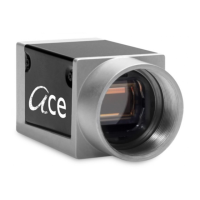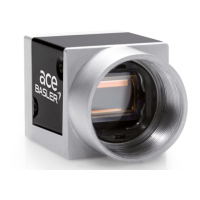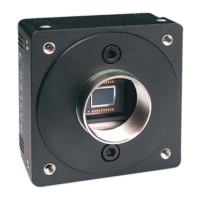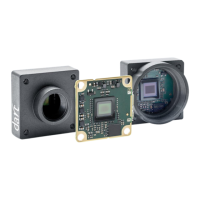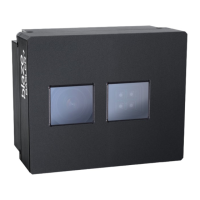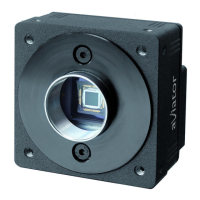Image Acquisition Control AW00123409000
110 Basler ace USB 3.0
If the Acquisition Mode parameter is set to Continuous, an Acquisition Start command does not
expire after a single frame is captured. Once an Acquisition Start command has been executed, you
can acquire as many frames as you like. The Acquisition Start command will remain in effect until
you execute an Acquisition Stop command. Once an Acquisition Stop command has been
executed, the camera will not be able to acquire frames until a new Acquisition Start command is
executed.
Frame Burst Start Trigger and the Trigger Mode
The frame burst start trigger is essentially an enabler for the frame start trigger.
The Trigger Mode parameter with parameter values off and on has a direct bearing on how the
Frame Burst Start Trigger works.
If the Trigger Mode parameter for the frame burst start trigger is set to off, the camera will generate
all required frame burst start trigger signals internally, and you do not need to apply frame burst start
trigger signals to the camera.
If the Trigger Mode parameter for the frame burst start trigger is set to on, the initial acquisition
status of the camera will be "waiting for frame burst start trigger" (see Figure 54 on page 111). When
the camera is in this acquisition status, it cannot react to frame start trigger signals. When a frame
burst start trigger signal is applied to the camera, the camera will exit the "waiting for frame burst
start trigger" acquisition status and enter a "waiting for frame start trigger" acquisition status. The
camera can then react to frame start trigger signals. The camera will continue to react to frame start
trigger signals until the number of frame start trigger signals it has received is equal to an integer
parameter setting called the Acquisition Burst Frame Count. At that point, the camera will return to
the "waiting for frame burst start trigger" acquisition status and will remain in that status until a new
frame burst start trigger signal is applied.
As an example, assume that the Trigger Mode parameter is set to on, the Acquisition Burst Frame
Count parameter is set to three, and the camera is in a "waiting for frame burst start trigger"
acquisition status. When a frame burst start trigger signal is applied to the camera, it will exit the
"waiting for frame burst start trigger" acquisition status and enter the "waiting for frame start trigger"
acquisition status. Once the camera has received three frame start trigger signals, it will return to
the "waiting for frame burst start trigger" acquisition status. At that point, you must apply a new
frame burst start trigger signal to the camera to make it exit "waiting for frame burst start trigger".
Frame Start Trigger and the Trigger Mode
Assuming that a frame burst start trigger signal has just been applied to the camera, the camera
will exit from the "waiting for frame burst start trigger" acquisition status and enter a "waiting for
frame start trigger" acquisition status. Applying a frame start trigger signal to the camera at this point
will exit the camera from the "waiting for frame start trigger" acquisition status and will begin the
process of exposing and reading out a frame (see Figure 54 on page 111). As soon as the camera
is ready to accept another frame start trigger signal, it will return to the "waiting for frame start
trigger" acquisition status. A new frame start trigger signal can then be applied to the camera to
begin another frame exposure.
The Trigger Mode parameter with parameter values off and on has a direct bearing on how the
Frame Start Trigger works.

